what to plant on east side of house shade area
Gardening in the shade has the reputation of being hard, only information technology doesn't have to be. Past choosing the right shade-loving plants, it's possible to accept a beautiful landscape even in limited light. Some of the nearly popular garden plants are reliable standbys for a reason: with the right location and care, they provide flavour-long enjoyment fifty-fifty for novice gardeners.
Here are some of the all-time shade plants to get yous started on the road to a lush, shady oasis:
On this folio: Leaf Plants | Flowering Plants | Trees | Online Learning
- FOLIAGE PLANTS FOR SHADE
- FLOWERING PLANTS FOR SHADE
- TREES FOR SHADE
- ONLINE LEARNING
- Elderberry VARIETIES
Leafage PLANTS FOR SHADE
Shadowland® 'Autumn Frost' hosta. Photograph by Proven Winners.
HOSTA
Regarded as queen of the shade garden, and it'south easy to see why. Hosta is grown for its attractive foliage in a wide variety of colors, patterns, shapes, and sizes ranging from teacup to truck tire-sized. This tough-equally-nails found is reliably hardy in colder zones, and performs best when provided with rich, well-amended soil and regular water. Many varieties tolerate deep shade and difficult sites, such as underneath trees. They combine well with many woodland plants that abound in shade, including coral bells, ferns, and columbine. These long-lived favorites will reward you with years of reliable color in the garden.
Height/Spread:
2 inches to iv feet alpine, 5 inches to half-dozen feet wide
Zones:
3-9
Plants to Try:
Shadowland® 'Autumn Frost', 'Patriot', 'Blue Angel', 'Gold Tiara', or 'June'.
Learn more almost growing hostas.
Primo® 'Peachberry Ice'. Photo past Proven Winners.
CORAL BELLS
For a nearly endless choice of foliage colors, patterns and forms, coral bells (Heuchera) fits the bill. From lemon xanthous to nearly black, there'southward a hue to match every garden palette, making this a landscape designer'due south dream plant. The flowers that explode like fireworks to a higher place the foliage in late jump/early summer are simply the icing on the cake. The piece of cake-care nature of this semi-evergreen perennial—including tolerance of a wide variety of light and soil conditions—makes this an ideal choice for most landscapes. They perform all-time in rich, well-draining soil that stays evenly moist. Coral bells are a versatile design element, suitable for mixed borders, mass plantings and containers.
Acme/Spread:
8 to 12 inches tall, 1 to 2 feet wide; flower stalks can attain two to 3 feet alpine
Zones:
3-9
Plants to Try:
Primo® 'Peachberry Ice', 'Marmalade', 'Plum Pudding', 'Ruddy Lightning'.
Larn more nearly growing coral bells.
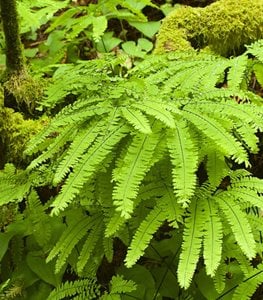
Maidenhair fern. Photograph by Janet Loughrey.
FERNS
Ferns are some of the oldest living plants, dating back to the historic period of the dinosaurs. A must-have addition to whatsoever woodland or shade garden, these reliable perennials are grown for their bonny fronds that lend texture and form to the landscape. There are dozens of garden-worthy species that are adjusted to a wide diversity of atmospheric condition. Most require rich soil and enough of moisture, though some such as Western sword fern (Polystichum munitum) are drought-tolerant afterwards establishment, making them a adept pick for challenging sites such equally dry out shade. Ferns pair well with nearly whatever woodland shade plant such as primrose (Primula), bishop's lid (Epimedium), hosta (Hosta), masterwort (Astrantia) and wood sorrel (Oxalis).
Superlative/Spread:
From the smallest fern in the world that measures only 1-centimeter alpine to tree-sized forms, in that location'southward a size to fit every landscape.
Zones:
There's a fern suitable to about every zone, from northern maidenhair fern (Adiantum pedatum, Z. iii) to species that thrive in tropical rain forests.
Plants to Try:
Japanese painted fern (Athyrium niponicum var. pictum), ostrich fern (Matteuccia struthiopteris), cinnamon fern (Osmundastrum cinnamomeum), maidenhair fern (Adiantum pedatum).
Heart to Heart™ 'Rose Glow'. Photograph by Proven Winners.
CALADIUM
For an exotic experience in the garden, few plants rival the bold impact of angel wings (Caladium). Made popular as a Victorian conservatory plant, this tropical almanac is grown for its pointer-shaped leaves in hues from pure white to multi-colored variegation. Information technology's virtually valuable for adding vibrant color to the darkest corners of your k where bright colors can be scarce. Caladium tin be grown from tubers or purchased as plants. Since they require a lot of heat to abound, they volition exercise all-time when obtained every bit plants for those in cooler climates or without a heat source such as a greenhouse or heating mat. Grow as a bedding constitute or in containers and combine with impatiens, begonias, and fuchsias.
Superlative/Spread:
half dozen inches to three feet tall, 1 to ii anxiety wide
Zones:
10-11
Plants to Try:
Heart to Heart™ 'Rose Glow', 'Miss Muffet', 'White Queen', 'Red Wink'.
Learn more nearly growing caladium plants.
ColorBlaze® Rediculous™ coleus. Photograph by Proven Winners.
COLEUS
One of the well-nigh pop summer annuals is coleus (Plectranthus, syn. Solenostemon), grown for its leafage that comes in a never-ending array of patterns, forms and colors. Coleus adopt rich soil that drains well and regular water, and can easily be reproduced from cuttings. Leaf color is best when planted in areas that get some direct light in the morning and protection from hot afternoon sun. This tropical is extremely versatile as a design element; utilize every bit a stand-lonely accent, massed as bedding plants, or in front of a mixed border. Combine in containers with flowering annuals such every bit million bells, impatiens, or fuchsia.
Pinnacle/Spread:
ii to v feet tall, iii feet wide
Zones:
10-11
Plants to Try:
ColorBlaze® Rediculous™, ' 'Blackness Dragon', 'Campfire', 'Wizard'.
Learn more than about growing coleus.
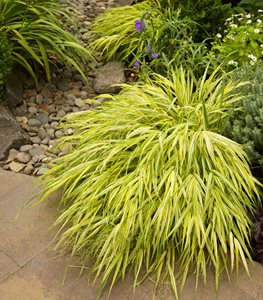
Golden Japanese forest grass. Photo past Janet Loughrey.
JAPANESE Wood GRASS
One of the few ornamental grasses that thrives in shade is Japanese forest grass (Hakonechloa macra). This deciduous perennial grows in low, mounding clumps. Golden or variegated species are valuable for lighting upwardly darker areas with their foliage. Tolerant of varying light conditions from fractional lord's day to deep shade, Japanese forest grass prefers rich, well-draining soil and regular moisture. Design uses are many: grow every bit a groundcover, massed along a slope, as a foundation planting, in containers or in the front of a mixed border. The graceful, arching habit and flowing foliage texture contrasts beautifully alongside hostas, hellebores, ferns and coral bells.
Height/Spread:
i to 2 anxiety tall, two feet broad
Zones:
five-9
Plants to Try:
'Aureola', 'All Gilded', 'Albo Striata', 'Nicolas'.
See more leafage plants: Proven Winners: Fab Foliage Plants for Shady Spaces
FLOWERING PLANTS FOR SHADE
Proven Accents® Pink Chablis®. Photograph by Proven Winners.
DEADNETTLE
Deadnettle (Lamium) is an easy intendance, reliable groundcover that'southward grown for its bonny multi-seasonal leafage and spring-blooming flowers of pink, white, or lavender. The lite-colored silver, white, yellow, or variegated foliage is effective for brightening deeply shaded areas. This deciduous or semi-evergreen perennial thrives in a wide range of weather condition, though it does best with partial to full shade and well-amended soil. This creeping groundcover fills in rapidly and can grow in difficult sites such every bit under trees or in dry shade, providing a rug of colour throughout the growing flavor. Abound on a slope, in larger areas in need of quick-growing vegetation, at the front of a mixed border, or in containers. Deadnettle tin can grow aggressively in certain areas. See where it has been identified equally invasive.
Summit/Spread:
3 inches to 2 feet tall, iii feet wide or greater
Zones:
four-nine
Plants to Endeavour:
Proven Accents® Pink Chablis®, 'White Nancy', 'Golden Anniversary', 'Beacon Silver', 'Chequers'.
'Cutting Edge' foamflower. Photograph by Proven Winners.
FOAMFLOWER
Foamflower (Tiarella), a archetype woodland found ethnic to North America, makes a welcome addition to any native garden. The delicate addiction of this dainty semi-evergreen perennial belies its toughness and reliability. Grown for its frothy flowers that bloom over an exceptionally long fourth dimension, the heart-shaped, lobed leaves in diverse patterns provide color year-round in milder regions. Foamflower tolerates deep shade, but performs best with dappled light that simulates their native woodland habitat. Plant in containers, stone gardens, or massed as a groundcover. Combine with other jump bloomers such as violets, Siberian bugloss (Brunnera), creeping phlox, and bleeding eye.
Height/Spread:
8 to 12 inches tall, one to 2 anxiety wide
Zones:
4-9
Plants to Endeavor:
'Cutting Edge', 'Crow Feather', 'Jeepers Creepers', 'Neon Lights', 'Pink Skyrocket'.
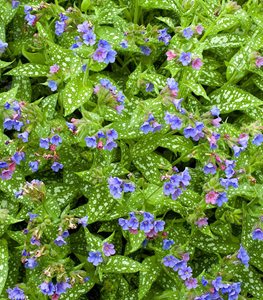
'Bertram Anderson' lungwort. Photograph by Janet Loughrey.
LUNGWORT
Ane of the well-nigh welcome sights in bound is the delightful flowers and foliage of lungwort (Pulmonaria). Among the primeval perennials to bloom, the showy flowers—in shades of blue, pink, coral, and white—emerge simultaneously with the attractive light-green, spotted or argent foliage that grows ever larger every bit the season progresses. This woodland favorite prefers rich soil and regular wet, performing well even in boggy sites. Combine with bleeding centre, hosta and leap-flowering bulbs for an uplifting display afterward the long, cold winter.
Acme/Spread:
6 to 12 inches tall, 1 to 2 feet broad
Zones:
3-9
Plants to Try:
'Night Vader', 'Raspberry Splash', 'Bertram Anderson', 'Sissinghurst White'.
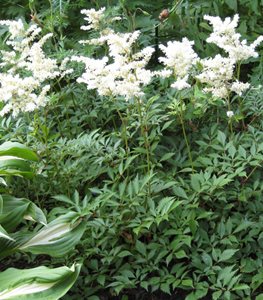
'Bridal Veil' astilbe. Photo past Sylvain Marineau / Millette Photomedia.
ASTILBE
Astilbe is a favorite of gardeners for its showy flower plumes that appear in summer subsequently many other woodland plants are finished blooming. The flowers of this deciduous perennial occur in hues of violet, pink, white and cherry, blooming above the frail ferny foliage, making this a real standout in the woodland garden. Astilbe prefers rich soil that stays constantly moist, and blooms best with part-day sunday. Mass as a basis cover in a woodland garden or shade border, or institute in containers. Combine with ferns, coral bells and hostas.
Height/Spread:
1 to 4 anxiety alpine and wide
Zones:
Most four-viii
Plants to Effort:
'Sprite', 'Visions', 'Bridal Veil', 'Ostrich Plumage'.
Learn more about growing astilbe.
Invincibelle Wee White® polish hydrangea. Photograph by Proven Winners.
HYDRANGEA
Hydrangea is i of the well-nigh revered garden plants, an erstwhile-fashioned favorite that blooms in summer and fall. This deciduous shrub comes in a wide range of species and forms, from the nigh popular mopheads (H. macrophylla) to hardy peegees (H. paniculata). About prefer regular h2o and rich amended soil, though oakleaf hydrangea (H. quercifolia) is drought-tolerant in some areas in one case established. Flowers are blue, white, purple, pink or cherry, with some having variable color according to soil pH. Plant in a mixed border, as a stand-alone emphasis, or as screening along a property border. Smaller specimens can be planted in containers. Hydrangeas practise prefer more brilliant shade than deep shade.
Height/Spread:
2 to 20 feet tall, 5 to 10 feet wide
Zones:
4-nine
Plants to Attempt:
Oakleaf hydrangea (H. quercifolia), H. macrophylla 'Harlequin', H. paniculata 'Limelight', H. arborescens Invincibelle Wee White® .
Larn more about growing hydrangeas.
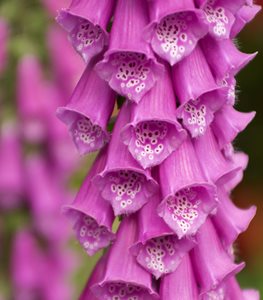
Common foxglove. Photo by Janet Loughrey.
FOXGLOVE
Foxglove (Digitalis) is a classic cottage-way favorite, grown for its statuesque spires of bong-shaped flowers that bloom in late spring and summer. The nearly common garden forms are biennial (D. purpurea), producing flowers in their second year. These self-sow readily for years of subsequent blossom, making them useful to fill in gaps. Other perennial species are a good choice for a mixed border. Foxgloves prefer rich, moist soil and blossom best when receiving at to the lowest degree function-twenty-four hours sun. Found along a gradient or naturalize in a woodland setting, cottage-mode garden, or wildflower meadow.
Height/Spread:
iii to 8 feet tall, 1 to iii feet wide
Zones:
3-8
Plants to Endeavour:
Mutual foxglove (D. purpurea), strawberry foxglove (D. xmertonensis), rusty foxglove (D. ferruginea), dusk foxglove (D. obscura).
Acquire more virtually growing foxglove.
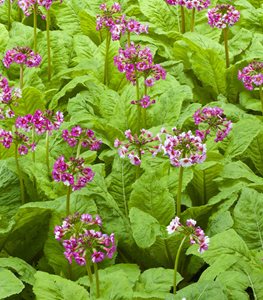
Japanese primrose. Photograph by Janet Loughrey.
PRIMROSE
A sure sign of spring, primrose (Primula) is a welcome sight later on a long, cold winter. The best known diversity, English language primrose (P. vulgaris), appears in garden centers in early on leap with cheerful hues of blue, pink, reddish, yellow and orange. There are dozens of other garden-worthy species, all of which perform best in cooler climates. Primroses prefer rich, well-draining soil, regular water and partial sun to deep shade, though alpine types can tolerate more light and dryer conditions. They combine well with many other woodland plants, including ferns, hosta, iris and haemorrhage centre. Naturalize in a woodland setting, constitute at the front of a mixed border, or in containers.
Pinnacle/Spread:
3 inches to 4 anxiety tall, 4 inches to 3 anxiety broad
Zones:
2-8
Plants to Effort:
Japanese primrose (P. japonica), candelabrum primrose (P. beesiana), drumstick primrose (P. denticulata), cowslip (P. veris).
Infinity® Pink Frost New Guinea impatiens. Photo past Proven Winners.
IMPATIENS
A acme choice of gardeners for shade bedding plants are impatiens (Impatiens walleriana), valued for their nonstop bloom from belatedly leap through frost. These tropical annuals come in a wide assortment of colors and are fast-growing, quickly filling in large areas. Impatiens prefer rich, well-draining soil, regular water, and are relatively low maintenance, requiring no deadheading. In contempo years, downy mildew has become a greater problem, so other disease-resistant forms such every bit New Guinea impatiens and SunPatiens® offer a feasible substitute. Breeders are working to develop other mildew-resistant forms, which will soon get available to abode gardeners. Mass in beds, plant at the front of a edge, or in containers.
Meridian/Spread:
ane to three feet tall and wide
Zones:
10-11
Plants to Try:
New Guinea impatiens (I. hawkeri), SunPatiens® (I. xhawkeri), jewelweed (I. capensis).
Learn more about growing impatiens.
'Gold Heart' old-fashioned haemorrhage center. Photograph past Proven Winners.
BLEEDING Heart
Few shade flowers rival the romance and intrigue of bleeding heart (Lamprocapnos syn. Dicentra spectabilis). The white, pink, or ruddy centre-shaped flowers are borne on arching stems above fern-like leaves. The virtually commonly grown diverseness of this deciduous perennial is L. spectabilis (syn. Dicentra spectabilis), a leap ephemeral that dies back in summertime. Establish these alongside hosta or other assuming-leafed plants that will grow up and cover the dying foliage. Bleeding middle grows all-time in rich, well-draining soil with regular wet. For longer-lasting plants, the foliage and flowers of fringed bleeding heart (D. eximia) or western bleeding heart (D. formosa) will last into fall with regular watering. Grow in a woodland setting with other shade lovers, or in a container equally a dramatic focal signal.
Height/Spread:
6 inches to 3 feet tall, one to 3 feet wide
Zones:
iii-nine
Plants to Try:
'Alba', 'Gold Heart', 'Valentine', 'Luxuriant'.
Larn more about growing bleeding heart.
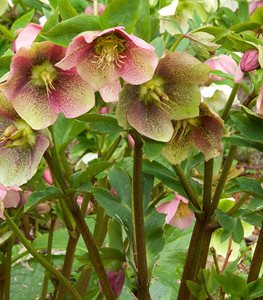
Hellebore hybrid. Photo by Janet Loughrey.
HELLEBORE
Hellebores (Helleborus) are coveted by gorging gardeners for their exceptionally long bloom time, cup-shaped flowers and bonny evergreen foliage. Christmas rose (H. niger) is the outset to blossom, beginning in December in milder regions, hence its name. Cheers to recent breeding breakthroughs, the most ordinarily grown species (H. xhybridus)—which blooms from late winter into jump—comes in a boundless array of colors and patterns. These tough plants prefer rich, well-draining soil, tolerate varying light conditions, and are virtually carefree once established. Naturalize in a woodland setting, constitute in front of a mixed border, or in containers. Combine with anemone, hosta, trillium and daffodils.
Superlative/Spread:
1 to iv feet tall, i to 3 anxiety wide.
Zones:
four-nine
Plants to Try:
Stinking hellebore (H. foetidus), Corsican hellebore (H. argutifolius), Winter Jewels®, 'Pinkish Frost'.
Learn more about growing hellebores.
TREES FOR SHADE
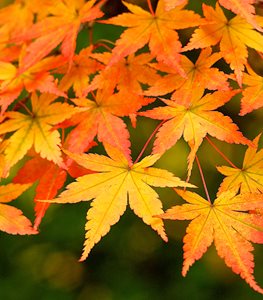
Japanese maple. Photo by Janet Loughrey.
JAPANESE MAPLE
Among the most love ornamental trees, Japanese maples (Acer palmatum) are grown for their multi-seasonal interest, elegant structure and brilliantly colored leafage in shades of red, orange, xanthous and purple. While some varieties grow into medium or tall trees, others stay smaller, making them suitable for urban lots. These deciduous trees do best when planted in rich, well-draining soil, and with regular water and protection from hot afternoon sun. Use as a backdrop in a mixed woodland border or as a stand-alone focal bespeak. Smaller specimens tin exist planted in containers.
Tiptop/Spread:
3 to xxx feet alpine, 3 to 25 anxiety broad
Zones:
5-8
Plants to Endeavour:
A. palmatum 'Bloodgood', A. palmatum 'Sango-kaku', A. japonicum 'Aconitifolium', A. palmatum 'Shishigashira'.
Learn more about growing Japanese maple copse.
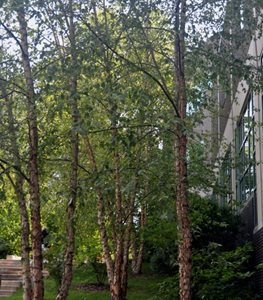
Dura-heat® river birch. Photo by Marietta Paternoster Garr / Millette Photomedia.
BIRCH
For natural woodland appeal, birch (Betula) copse make a valuable addition to the landscape for their elegant stature, autumn color, and ornamental bark that is especially bonny in winter. Some varieties are extremely hardy, making them a proficient selection in colder regions. These deciduous trees are fast growing and perform best in rich, well-draining soil with regular water and at least part-mean solar day sun. Because there are so many options to cull from, it'southward important to research which ones volition do best in your region, and to choose a variety that will non outgrow its infinite. Plant near a stream or pond, in a row to divide garden spaces, group as an allée, or utilize a single specimen equally a properties in a mixed edge.
Acme/Spread:
5 to 80 anxiety tall, 5 to 40 feet wide
Zones:
2-ix
Plants to Try:
B. papyrifera (paper birch), B. nigra (river birch), B. pendula (weeping birch), B. populifolia ('Whitespire' greyness birch).
Larn more almost growing birch trees.
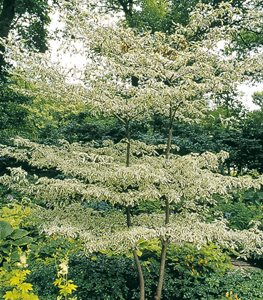
Pagoda dogwood. Photo past Bertrand Dumont / Millette Photomedia.
DOGWOOD
Grown for its showy flowers and statuesque habit, dogwood (Cornus) is synonymous with leap. While nearly are deciduous copse, there are also shrub and groundcover forms. Tree varieties most available to home gardeners tend to be small to medium-sized, making them suitable to urban lots and curbside strips where ability lines are a business. Some varieties prefer full sun, though others are suited to the dappled shade of their native woodland habitat. Employ equally a backdrop or focal indicate in a mixed border, or as a stand-lonely focal betoken in a lawn. Grow with compatible understory plants such every bit daffodils, sweet woodruff, hosta and ferns.
Height/Spread:
ten to 50 feet tall, six to 50 feet wide
Zones:
4-nine
Plants to Endeavour:
C. alternifolia (pagoda dogwood), C. controversa 'Variegata' (wedding block tree), C. kousa (kousa dogwood), C. florida f. rubra (Eastern dogwood).
Larn more well-nigh growing dogwood trees.
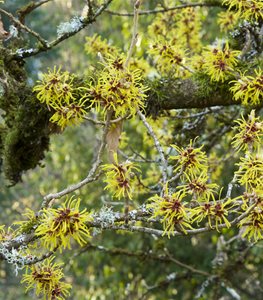
Chinese witch hazel. Photograph by Janet Loughrey.
WITCH HAZEL
In the dead of winter when there is little life in the garden, the delicate ribbon-like flowers of witch hazel (Hamamelis) cheer up even the dreariest days. The graceful vase-shaped structure is only a bonus, with some varieties having boosted attributes of autumn color or fragrance. This deciduous tree or shrub needs virtually no intendance once established, with most suitable for minor spaces. Abound as a stand-alone focal point, along a property border, or near your habitation's entrance or sidewalk where the fragrance can be enjoyed up shut. Smaller specimens can exist grown in containers. Combine with other plants with winter interest such equally hellebores, snowdrops, and heathers.
Height/Spread:
12 to fifteen anxiety alpine and broad
Zones:
iii-nine
Plants to Endeavor:
H. tenintermedia'Jelena', H. xintermedia 'Aphrodite', H. xintermedia 'Diane', Chinese witch hazel (H. mollis).
Acquire more about growing witch hazel.
ONLINE LEARNING
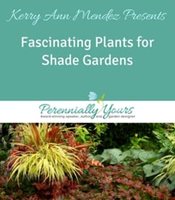
FASCINATING PLANTS FOR SHADE GARDENS
Plant practiced Kerry Ann Mendez introduces yous to a wide variety of perennials, flowering shrubs, annuals, bulbs and flowering vines for shade gardens in Zones iii to eight. Get blueprint tips and constitute combinations that volition have you eager to establish up the shady spots in your garden.
RELATED:
19 Amazing Shade Annuals
Container Gardens Made for the Shade
Shade Garden Pictures
Source: https://www.gardendesign.com/shade/plants.html
0 Response to "what to plant on east side of house shade area"
Postar um comentário